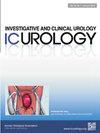COL6A1表达是T1高级别膀胱癌风险分层的潜在预后生物标志物:揭示独特的非肌层浸润性亚型的侵袭本质
IF 2.5
3区 医学
Q2 UROLOGY & NEPHROLOGY
引用次数: 0
摘要
目的ET1 高分化(T1HG)膀胱癌(BC)是非肌层浸润性膀胱癌(NMIBC)的一种类型,被认为是一种侵袭性亚型,具有更高的进展倾向。目前的 NMIBC 风险分层方法依赖于临床病理学指标;然而,这些方法并不能充分体现 T1HG BC 的侵袭性。因此,需要新的、更准确的生物标志物对 T1HG 进行风险分层。在此,我们招募了三个不同的患者队列,研究了细胞外基质的关键成分六型胶原α1(COL6A1)在 BC 不同阶段和不同等级的表达情况,并特别关注 T1HG BC。结果我们发现,T1HG BC 和肌浸润性 BC(MIBC)的 COL6A1 表达量相当,明显高于其他 NMIBC 亚型。特别是,后来进展为MIBC的T1HG患者的COL6A1表达量大大高于Ta、T1低级别患者和未进展的患者,这突显了T1HG BC的侵袭性和较高的进展风险。此外,Cox和Kaplan-Meier生存分析表明,COL6A1表达升高与T1HG BC患者无进展生存期差之间存在显著关联(多变量Cox危险比,16.812;95%置信区间,3.283-86.095;P=0.001和P=0.0002 [对数秩检验])。本文章由计算机程序翻译,如有差异,请以英文原文为准。
COL6A1 expression as a potential prognostic biomarker for risk stratification of T1 high grade bladder cancer: Unveiling the aggressive nature of a distinct non-muscle invasive subtype.
PURPOSE
T1 high grade (T1HG) bladder cancer (BC) is a type of non-muscle invasive BC (NMIBC) that is recognized as an aggressive subtype with a heightened propensity for progression. Current risk stratification methods for NMIBC rely on clinicopathological indicators; however, these approaches do not adequately capture the aggressive nature of T1HG BC. Thus, new, more accurate biomarkers for T1HG risk stratification are needed. Here, we enrolled three different patient cohorts and investigated expression of collagen type VI alpha 1 (COL6A1), a key component of the extracellular matrix, at different stages and grades of BC, with a specific focus on T1HG BC.
MATERIALS AND METHODS
Samples from 298 BC patients were subjected to RNA sequencing and real-time polymerase chain reaction.
RESULTS
We found that T1HG BC and muscle invasive BC (MIBC) exhibited comparable expression of COL6A1, which was significantly higher than that by other NMIBC subtypes. In particular, T1HG patients who later progressed to MIBC had considerably higher expression of COL6A1 than Ta, T1 low grade patients, and patients that did not progress, highlighting the aggressive nature and higher risk of progression associated with T1HG BC. Moreover, Cox and Kaplan-Meier survival analyses revealed a significant association between elevated expression of COL6A1 and poor progression-free survival of T1HG BC patients (multivariate Cox hazard ratio, 16.812; 95% confidence interval, 3.283-86.095; p=0.001 and p=0.0002 [log-rank test]).
CONCLUSIONS
These findings suggest that COL6A1 may be a promising biomarker for risk stratification of T1HG BC, offering valuable insight into disease prognosis and guidance of personalized treatment decisions.
求助全文
通过发布文献求助,成功后即可免费获取论文全文。
去求助
来源期刊

Investigative and Clinical Urology
Medicine-Urology
CiteScore
4.10
自引率
4.30%
发文量
82
审稿时长
4 weeks
期刊介绍:
Investigative and Clinical Urology (Investig Clin Urol, ICUrology) is an international, peer-reviewed, platinum open access journal published bimonthly. ICUrology aims to provide outstanding scientific and clinical research articles, that will advance knowledge and understanding of urological diseases and current therapeutic treatments. ICUrology publishes Original Articles, Rapid Communications, Review Articles, Special Articles, Innovations in Urology, Editorials, and Letters to the Editor, with a focus on the following areas of expertise:
• Precision Medicine in Urology
• Urological Oncology
• Robotics/Laparoscopy
• Endourology/Urolithiasis
• Lower Urinary Tract Dysfunction
• Female Urology
• Sexual Dysfunction/Infertility
• Infection/Inflammation
• Reconstruction/Transplantation
• Geriatric Urology
• Pediatric Urology
• Basic/Translational Research
One of the notable features of ICUrology is the application of multimedia platforms facilitating easy-to-access online video clips of newly developed surgical techniques from the journal''s website, by a QR (quick response) code located in the article, or via YouTube. ICUrology provides current and highly relevant knowledge to a broad audience at the cutting edge of urological research and clinical practice.
 求助内容:
求助内容: 应助结果提醒方式:
应助结果提醒方式:


